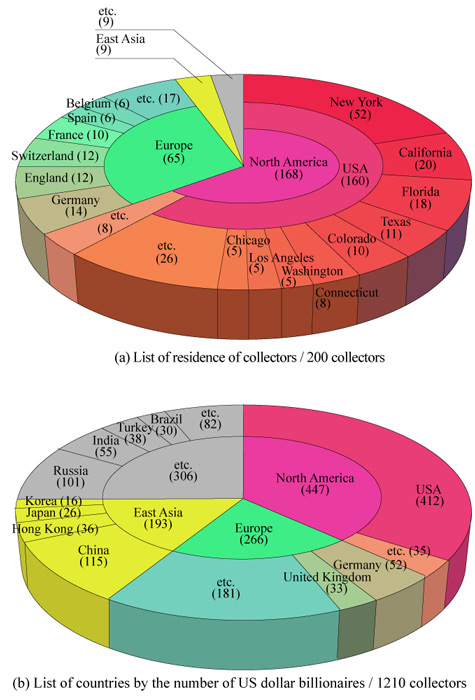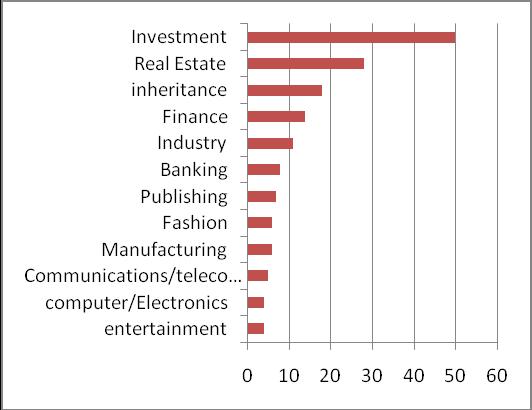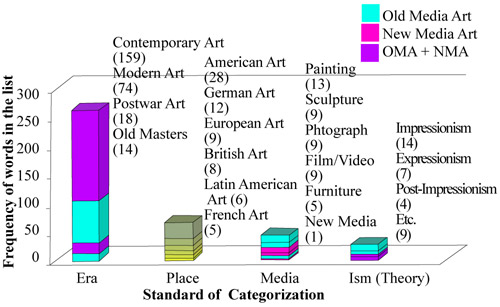Buyer of New Media Art
Published in C.A.N. Magazine [http://cicamuseum.com/issue-buyer-of-new-media-art]
Feb. 13, 2014
Fig. 1. (a) Places of residence of top 200 collectors [1] (top) and (b) countries by the number of US dollar billionaires announced by Forbes (http://www.forbes.com/wealth/billionaires) (bottom). Regarding the top chart, the place in which less than four collectors reside have been omitted from the chart. Regarding the bottom chart, only countries ranked in the top ten have been listed (with the exception of Korea).
Traditional art works exhibited in galleries and museums are enjoyed by visitors and sold by collectors. Meanwhile, sponsorship is a different concept. Rather than dealing art as cultural goods like collectors, sponsors support individual artists, art projects, events, or exhibitions. While many collectors are individuals, sponsors can be individuals, companies, or commercial/non-commercial foundations.
Regarding the new media art market, including video, web, and interactive art, the existing collector model is problematic. Since what is defined as new media art is often not a single object made out of tangible materials, but a complex installation work or an event involving electronic devices and performances, it is hard to define what part of new media art can be sold to collectors, such as a digital file, a documentation of the event, or the whole installation of new media art including electronic devices. More problematic is the concern that electronic devices have relatively short life spans compared to archival art pieces. Even if one collector buys a whole installation of new media art, it is hard to maintain the work since all electronic devices will need to be replaced or repaired at some point due to the failure or discontinuation of the purchased models. Thus, new media art installations must be maintained by artists or experts with detailed instructions in order to protect the investment in the work.
To better understand buyer groups for contemporary art, an analysis to the list of the most active 200 collectors in 2011 reported by Art News Magazine [1] has been included in this article (See Fig.1). In the article, Art News annually announces the top 200 collectors with the information of names, residences, professions, and areas of interest in collecting. This analysis help determine characteristics of art collectors.
The top chart pictured in Fig. 1 illustrates the places of residence of the world’s most active 200 collectors of 2011. However, the places in which less than four collectors reside have been omitted from the chart. Since the majority of collectors reside in more than two places, I counted each place as one. Therefore, the total number of the residences exceeds 200, the total number of collectors. Of the 200 collectors, 160 reside in the United States, and 63 reside in Europe. Within the US, 52 out of 200 collectors, more than a quarter, reside in New York City. This chart visualizes the concentration of art collectors in New York City.
However, methods Art News used to gathered the data around the world and its credibility is questionable. For instance, in the case of China, China was reported as the second largest country in the consumption of luxury goods totaling $ 9.4 billion in 2009, and accounting for 27.5% in global sales of luxury goods [2]. However, none of the 200 collectors resides in China except for two in Hong Kong and two in Taiwan. According to Skate’s Art Market Research on China in 2011 (http://skatesartinvestment.com), the art market in China is “one of the fast growing source of demand standing at the T-intersection of the ‘Japanese’ and ‘American’ ways [3].” Therefore, the data collected by art news is debatable, specifically the data that suggests that majority of “top” art collectors reside in the US.
The bottom chart of Fig. 3 illustrates the list of countries by the number of billionaires reported on the Forbes website (http://www.forbes.com/wealth/billionaires). Like the list of 200 art collectors, the majority of billionaires were from the United States and Europe. However, the percentage of East Asian and unlisted countries in the list of billionaires is much higher than that of 200 collectors. While 9% of the 200 collectors were from East Asia and unlisted countries, 41% of 1,210 billionaires were from East Asia and unlisted countries. The discrepancy may be inferred due to two possible causes: 1) there were errors in the data or 2) there is a tendency that the Western countries invest in art more than other countries.
Fig. 2. Professions of Top 200 Collectors [8]. The majority of collectors work in investment, real estate, and inheritance.
Fig. 2 indicates the professions of the top 200 collectors. Based on the information, the majority of collectors’ capital is supplemented by investment, real estate, and inheritance, rather than working salaried positions.
Fig. 3. The categorization of areas of interest in collection of the top 200 collectors [1]. The collectors’ interest in collection was categorized into four standards: Era, Place, Media, and Theory. The majority of categorization standard was by era. Of the 200 collectors, 159 were interested in contemporary art but only one collector was specifically collecting new media art. (NMA=New Media Art, OMA=Old Media Art)
Fig. 3 indicates the 200 collectors’ areas of interest in art collecting. Art News categorized areas of Art based on multiple standards: Era, Place, Media, and Theory. The meanings of the terms are sometimes ambiguous or overlap with each other, and therefore do not provide specific information about certain collectors. For instance, while the area of interest of Pierre Chen was “Western and Chinese modern and contemporary art and Chinese imperial porcelain and art,” Uli Knecht was interested in collecting “Contemporary art, especially Pop and German art.” The terms such as “Western,” “German,” “Pop,” and “Contemporary” have different standards of categorization, which make it difficult to analyze the list. In addition, statistics suggest that collectors tend to collect art works from their own countries or regions.
The majority of categorization methodologies used by Art News were based on eras such as “Contemporary,” “Modern,” “Postwar,” and “Old Masters.” Following eras, place is the second most popular methods to categorize collecting trends. It was observed that collectors tend to collect art from their place of residence. Third, some collectors collect works based on media, such as “Painting,” “Sculpture,” “Film/Video,” and “New Media.” Finally, some collectors collect art works based on theories, such as “Expressionism,” “Impressionism,” “Minimalism,” and “Feminism.”
In the top 200 collectors list, only one collector was specified as collecting new media art. While traditional media art such as sculpture and painting can be easily purchased by collectors, new media art is problematic in terms of its category due to the complexity of its output and the ephemeral nature of the medium.
Based on the result from the top 200 collectors, the existing art collector model of art does not include new media art due to the difficulties of preservation of new media art as ephemeral cultural property. In conclusion, based on the lack of statistical data on new media art and its collectors, the new media art market is in need of new forms of sponsorship, which may be a project sponsor or a distributor.
[1] http://www.artnews.com/2011/08/15/the-artnews-200-top-collectors-2011/ The ARTNews 200 top collectors, Summer 2011.
[2] http://www.china-online-marketing.com/news/china-market-news/china-luxury-market-report/ China consumption of Luxury Goods.
[3] http://skatesart.files.wordpress.com/2011/04/skates_market_notes-18-04-20112.pdf Some Musings about the Future of the Chinese Art Market.



